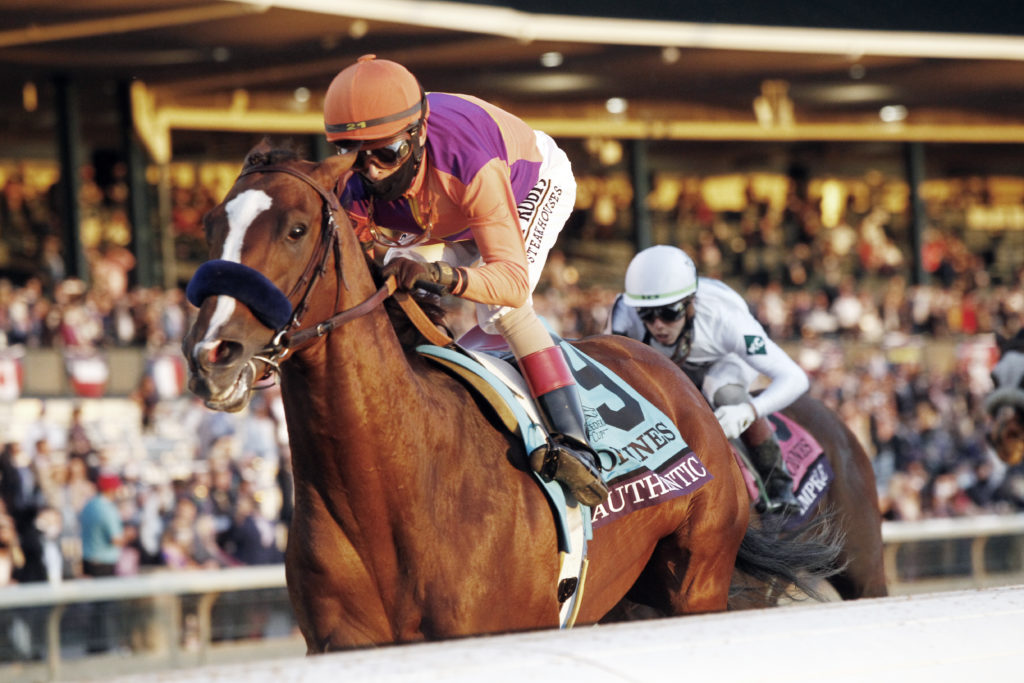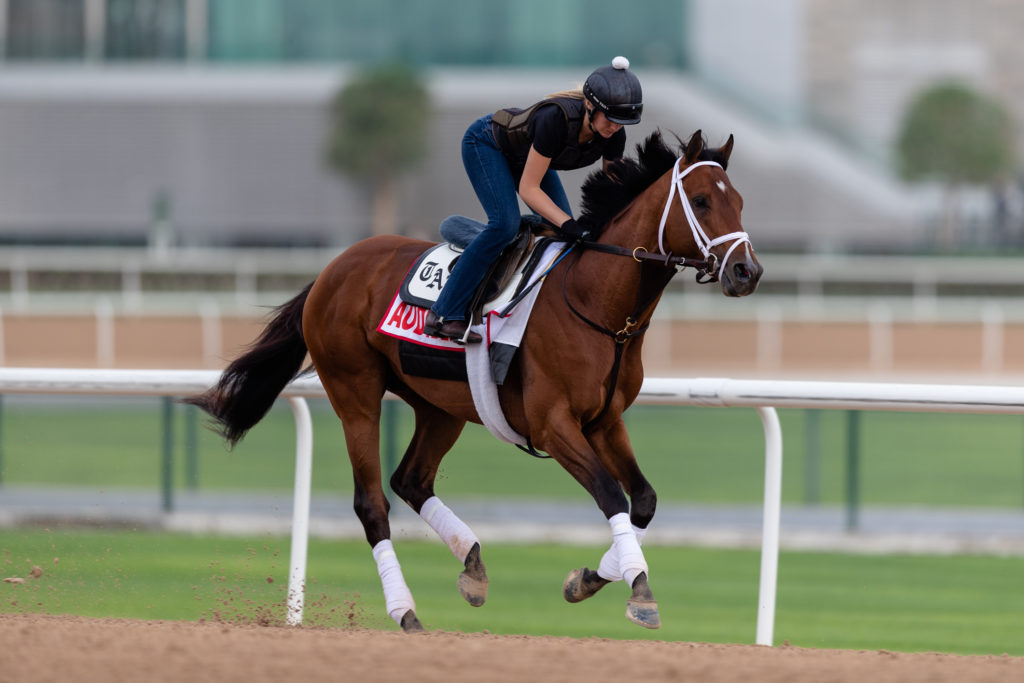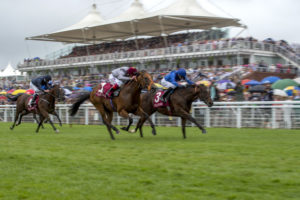Considering that the Blood-Horse’s 2010 Stallion Register credited Storm Cat with no fewer than 160 stallion sons worldwide, it’s hardly surprising that the male line descending from this two-time champion American sire has been flying high in recent years. And it is also hardly surprising that one of the high-flying branches descends from his outstanding son Giant’s Causeway, a multiple champion sire who gave us Shamardal, himself sire of Lope De Vega, Blue Point, Earthlight and Pinatubo.
Giant’s Causeway is also the sire of Not This Time, one of the North American “buzz” sires of 2020 whose first-crop juveniles did so well that his fee has been raised from $12,500 to $40,000.
Fortunately, the bloodstock world isn’t always so straightforward and some of the other highflyers from the Storm Cat male line have emerged from less obvious sources. A prime example is Scat Daddy, who gave us No Nay Never, Caravaggio and Triple Crown winner Justify. Although Scat Daddy was a Grade 1 winner at two and three, he laboured under the handicap of being a son of Johannesburg.
Admittedly, Johannesburg had been spectacularly successful as a two-year-old but he struggled to maintain the considerable success achieved by his first crop and was sold to Japan in 2009. This didn’t help Scat Daddy, who had made his stallion debut the previous year at a fee of $30,000. Over the next three years his price fell to $22,500, then $15,000 before crashing to $10,000 in his fourth season.
Scat Daddy had also been shuttled to Chile, a comparative backwater in the breeding world, so he beat the odds by developing into such an effective stallion, despite never having stood for more than $35,000 during an eight-year career (he was scheduled to stand the 2016 season at $100,000 but died in December 2015).
“Those closest to the stallion never imagined success on such a grand scale for Into Mischief”
Now the shining star of the American industry is Into Mischief, who has replaced War Front as America’s highest-priced stallion, at a fee of $225,000, following his second successive sires’ championship – the latest of which saw him establish an all-time single-season record for a sire in North America with a treasure chest of over $22 million. No other stallion has ever topped $20 million, but Into Mischief did so with the help of Horse of the Year Authentic, winner of the Kentucky Derby and Breeders’ Cup Classic, and champion female sprinter Gamine.
It’s surely safe to say that even those closest to the stallion never imagined success on such a grand scale for Into Mischief, who – like Scat Daddy – is a great-grandson of Storm Cat.
Although his grandsire Harlan managed to win a Grade 1 race, that win – in the 1994 Vosburgh Stakes – represented Harlan’s only stakes success in a 30-race career. Attracting mares didn’t prove easy for Harlan and his death at the age of ten meant that he left only 99 named foals. However, each of his first two crops contained a colt destined to rank among the best of their age at three. The first, Menifee, was runner-up in the first two legs of the 1999 Triple Crown and the second was Into Mischief’s sire Harlan’s Holiday, who was conceived at a fee of only $5,000.
Bred in Ohio, where he was to make some of his early starts, Harlan’s Holiday went into training with Ken McPeek. Whereas Harlan had never raced as a two-year-old, his son made six juvenile starts, five of them at stakes level, and he was never worse than second. Harlan’s Holiday’s four stakes victories earned him a weight of 114 on an Experimental Free Handicap topped by Johannesburg at 126lbs. He was even more effective at three, when a ten-race campaign yielded Grade 1 victories in the Florida Derby and Blue Grass Stakes. Another nine- furlong Grade 1 race – the Donn Handicap – fell to Harlan’s Holiday as a four-year-old, but his International Classification of 118 placed him 15lbs below top-ranked Hawk Wing.
While clearly tough and talented, Harlan’s Holiday fell some way short of the very best, as he showed when only seventh when favourite for the Kentucky Derby. The possibility existed, though, that this son of a sprinter didn’t have the stamina for distances beyond a mile and an eighth.

2020 Breeders’ Cup hero Authentic is by Spendthrift’s Into Mischief
With a less-than-fashionable sire, Harlan’s Holiday was priced at $17,500 when he took up stallion duties at Airdrie Stud in 2004 – a year which saw his fellow newcomers Empire Maker and Mineshaft command fees of $100,000. On the plus side, his original trainer McPeek was full of admiration for the colt, once commenting that “he’s got so much speed and it’s tactical speed. He’s just a very talented horse, a very easy horse to handle. He’s push-button, no problem.”
There was also plenty to admire about the bottom half of his pedigree. In addition to having the Triple Crown winner Affirmed as his broodmare sire, his third dam was Princessnesian, a top-class racemare who was also a half-sister to the important stallion Boldnesian and to some very good broodmares.
Airdrie Stud has an enviable reputation for making stallions and Harlan’s Holiday wasted no time in making his mark, going close to first-crop sire honours in 2007, with the help of five individual stakes winners led by Into Mischief.
There appeared to be no special reason to expect Into Mischief to be anything out of the ordinary. He was the third foal of Leslie’s Lady, a daughter of the Grade 2-winning stallion Tricky Creek. Conceived at a fee of only $2,500. Leslie’s Lady was sold twice as a yearling, for only $8,000 and $27,000. To her credit, Leslie’s Lady became a stakes winner, but only at Hoosier Park in the backwater of Indiana.
In the circumstances breeder James T. Hines Jr must have been satisfied when Leslie’s Lady’s colt by Harlan’s Holiday sold for $80,000 as a yearling at Fasig-Tipton in October. However, that satisfaction was no doubt diminished when the colt was resold less than six months later for $180,000 at Ocala in Florida.
“There appeared to be no special reason to expect Into Mischief to be anything out of the ordinary
The colt’s sale at Ocala was to prove central to Into Mischief’s career, as his purchaser was B. Wayne Hughes, owner of Spendthrift Farm, where Into Mischief has been based since the start of 2009. The story goes that Hughes’ team had considerable difficulty choosing between two very similar Harlan’s Holiday colts at Ocala before finally opting for Into Mischief, after reviewing the video of his work on the dirt track. He had worked a furlong in :10 2/5 seconds, just 2/5ths of a second slower than the fastest works. Interestingly, Into Mischief’s buyer was .the sale’s leading purchaser, picking up four youngsters for $1.05 million, with Into Mischief the cheapest of the four.
One member of the selection team had pointed out that Into Mischief was a little over at the knee, but trainer Richard Mandella wasn’t concerned, and how right he was! After allowing the colt time to recover from his sales exertions, Mandella was rewarded with two wins and a second from three starts in California.
Into Mischief was impressive on his debut on the Cushion Track at Santa Anita on October 21, setting fractions of :21.87 and :44.58 on his way to a final time of 1:14.36 for six and a half Grade 3 Hollywood Prevue Stakes over seven furlongs, Into Mischief stepped up to 1 1/16 miles in the Grade 1 CashCall Futurity, again over Hollywood Park’s all-weather track. He finished well to score by just over a length from future Grade 1 winner Colonel John.
While Colonel John was garnering his Grade 1 successes as a three-year-old, Into Mischief was on the sidelines, following a disappointing second in the Grade 2 San Vicente Stakes in February. He wasn’t seen out again until late- October, when he inflicted a decisive defeat on the future Breeders’ Cup Sprint winner Dancing In Silks in the Damascus Stakes over seven furlongs on the Santa Anita all-weather. Into Mischief’s final appearance came over the same course and distance at the end of 2008, when he could finish only second as favourite for the Grade 1 Malibu Stakes.
So Into Mischief’s career ended after a mere six starts, spread out over 14 months. While breeders could justifiably wonder about his soundness, his difficulties related to his feet, rather than the usual problem areas. It was reportedly these foot problems which had kept him off the Kentucky Derby trail.

Audible: the Grade 1 winner joined WinStar’s roster for 2020 – Photo: DRC/Neville Hopwood
There was never any hope that Into Mischief would be allowed to make up for lost time as a four-year-old, as it had been announced in the September of his second season that he would be retiring to Spendthrift in 2009. Sure enough, he was retired just days after the Malibu Stakes, to commence stallion duties at a fee of $12,500. Clearly, he was still something of an unknown quantity. All six of his starts had been on all-weather surfaces and he had only once raced around two turns.
Predictably, there wasn’t a mad rush for his services. Into Mischief attracted no more than 61 mares in his first year, 44 in his second, 54 in his third and 50 in his fourth, in 2012. His fee was quickly on the slide too, to $7,500 in his third and fourth seasons. He ended up with a total of 143 named foals in these first four crops, which put him at a considerable numerical disadvantage in an industry where popular American stallions, such as Uncle Mo, can sire more than 150 foals in their first crop.
However, Spendthrift took steps to remedy the situation with the introduction in 2010 of its Share The Upside programme, whereby breeders could earn a lifetime breeding right to a stallion if they sent him a mare for two consecutive years. While Into Mischief’s figures remained low, the programme is credited with earning him just enough support to stand a chance.
Into Mischief’s first runners did so well that Spendthrift had to keep revising his fee for 2013. Having initially announced in November 2012 that his fee would remain at $7,500, it was quickly raised to $10,000. This was in response to overwhelming demand for nominations fuelled by Goldencents’ victory in the Grade 3 Delta Downs Jackpot Stakes in November, Sittin At The Bar’s easy win in the Louisiana Champions Day Lassie on December 8 and by Vyjack’s win in the Traskwood Stakes on December 9. Between them they helped Into Mischief take third place on the first-crop sires’ table, just $60,000 behind the champion. Then Vyjack and Goldencents achieved a Graded stakes double on January 5, sending his 2013 fee up to $20,000.
His fee has hardly stopped rising ever since. His 2021 three-year-olds are off a $75,000 fee and his current two-year- olds were sired at $100,000.
The best may yet to be to come, bearing in mind that he stood for $150,000 in 2019, $175,000 in 2020 and is now priced at $225,000.
Into Mischief’s appeal also received a couple of substantial boosts from his parents. Harlan’s Holiday became 2012’s leading sire of two-year-olds, thanks to a team of five stakes winners led by champion Shanghai Bobby. More importantly, Into Mischief’s dam Leslie’s Lady continued to thrive with stallions from the Storm Cat male line.
“Into Mischief attracted no more than 61 mares in his first year, 44 in his second, 54 in his third and 50 in his fourth, in 2012”
Mated to Henny Hughes, she produced that remarkable mare Beholder, a dual Breeders’ Cup winner for Spendthrift who achieved champion honours at the ages of two, three, five and six. Then Leslie’s Lady’s Scat Daddy colt Mendelssohn justified his $3-million yearling price by winning the Breeders’ Cup Juvenile Turf and the UAE Derby. No wonder Leslie’s Lady was named 2016’s Broodmare of the Year. Her 2018 American Pharoah filly, America’s Joy, sold for a record $8.2 million as a yearling.
Hardly a day seems to go by without Into Mischief being represented by a winner or two and his tally in 2020 stood at 189 winners – at least 34 more than any other American stallion. No fewer than 29 became black-type winners and 74 of his progeny won more than once. In terms of conformation, he is medium- sized and well proportioned, with a shorter back than his sire Harlan’s Holiday. He is correct, as was his sire, and arguably the most striking aspect of his physique is his rear end, with excellent hips and hind-leg.
He is also no doubt finding it helpful that his pedigree is free of many of the ubiquitous names in American breeding, such as Mr Prospector, Seattle Slew and Danzig. He owes his eight Grade 1 winners to daughters of Mr Greeley, Speightstown, Unbridled, Distorted Humor, Banker’s Gold, Gilded Time, Kafwain and Indian Charlie.
The average winning distance for Into Mischief’s progeny in North America stands at 6.73 furlongs, and his progeny are renowned for their speed, thanks partly to the exploits of those fast fillies Covfefe and Gamine. There are solid reasons, though, for thinking that his progeny from his higher-priced crops will include more performers in the mould of his Kentucky Derby winner Authentic and his Florida Derby winner Audible.
His Grade 1 victory was gained over 1 1/16th miles, on the only occasion he ventured beyond seven furlongs. With nine-furlong specialists as his sire and broodmare sire, Into Mischief wasn’t bred to be a sprinter, as has been borne out by the exploits of his younger siblings. Also, Into Mischief’s second, third and fourth dams were all by stallions – Stop The Music, One For All and Sea-Bird – who won over at least a mile and a quarter.
As Into Mischief is now 16-years-old, the time is ripe for some of his stallion sons to come to the fore. There has been plenty of hype about the first two-year- olds by Practical Joke, a dual Grade 1-winning two-year-old based at Coolmore’s Ashford Stud. His first yearlings sold for up to $575,000 and his first two-year-olds include a filly which topped the OBS March Sale at $750,000.
Even so, it appears that Into Mischief’s charms have largely been wasted on European owners and breeders. He has had only three runners in Britain (two of them winners), three in France and none in Ireland. At a time when outcrosses are urgently needed, perhaps it is time for Europe to give him much more serious consideration.



